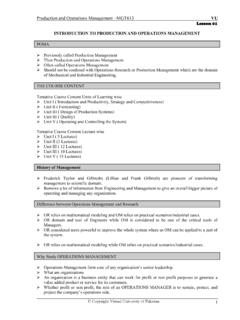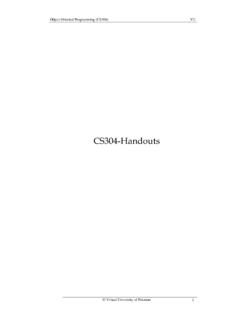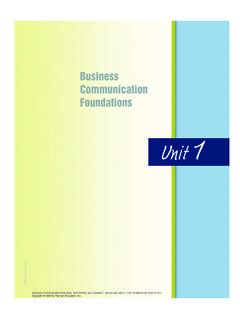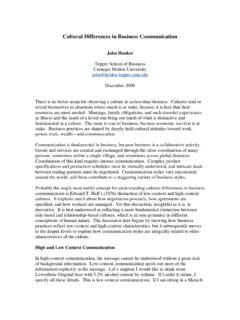Transcription of English for Business Communication Teacher's book ...
1 ( Introduction Module 1 Cultural diversity and socialising Unit 1 Building a relationship Briefing 1 Cross-cultural understanding ( I ) 2 Welcoming visitors 3 Small talk: keeping the conversation going Unit 2 Culture and entertainment Briefing 1 Cross-cultural understanding (2) 2 Inviting, and accepting or declining 3 Eating out Module 2 Telephoning Unit 3 Could I leave a message? Briefing 1 Preparing to make a telephone call 2 Receiving calls 3 Taking and leaving messages 4 Asking for and giving repetition 5 The secretarial barrier Unit 4 Good to hear from you again! Briefing 1 Cross-cultural Communication on the telephone (1) 2 Setting up appointments 3 Changing arrangements 4 Ending a call Unit 5 Unfortunately there's a problem .. Briefing 1 Cross-cultural Communication on the telephone (2) 2 Problem-solving on the telephone 3 Complaints Module 3 Presentations Unit 6 Planning and getting started Briefing 1 Presentation technique and preparation 2 The audience 3 Structure (1) The introduction Unit 7 Image, impact and making an ImpreSSIOn Briefing 1 Using visual aids: general principles 2 Talking about the content of visual aids 3 Describing change IV 1 1 1 4 6 10 10 10 1 1 16 ]8 18 18 19 20 23 24 27 27 27 29 32 33 36 36 36 36 38 43 43 43 45 46 50 50 50 SI SS Unit 8 The middle of the presentation Briefing 1 Holding the audience's attention 2 Structure (2) The main body 3 Listing information 4 Linking ideas 5 Sequencing Unit 9 The end is near.)
2 This is the end Briefing 1 Structure (3) The end 2 Summarising and concluding 3 Questions and discussion Module 4 Meetings Unit 10 Making meetings effective Briefing 1 What makes a good meeting? 2 Chairing a meeting 3 Establishing the purpose of a meeting Unit 11 Sorry to interrupt, but .. Briefing 1 The structure of decision-making 2 Stating and asking for opinion 3 Interrupting and handling interruptions Unit 12 What do you mean by .. ? Briefing 1 Asking for and giving clarification 2 Delaying decisions 3 Ending the meeting Module 5 Negotiations Unit 13 Know what you want Briefing 1 Types of negotiation 2 Preparation for a negotiation 3 Making an opening statement Unit 14 Getting what you can Briefing 1 Bargaining and making concessions 2 Accepting and confirming 3 Summarising and looking ahead Unit 15 Not getting what you don't want Briefing 1 Types of negotiator 2 Dealing with conflict 3 Rejecting 4 Ending the negotiation Optional case studies 5R 58 58 59 59 61 62 65 65 65 66 6R 74 74 74 76 7R 83 83 83 84 86 91 9]
3 91 93 94 98 98 98 100 101 105 105 105 107 109 112 112 112 112 115 117 119 I This second edition provides improvements to the overall design and appearance of the book as well as various small changes and updating of material. The most important content change is the introduction of more practice exercises in response to users' requests. See the paragraph Quick Communication Check below. Aims of the course The course is intended as an opportunity for intermediate-level students to develop confidence and fluency in five key Communication contexts: socialising, telephoning, presenting information, participating in meetings and handling negotiations. The course has twin aims: improving Communication technique and developing and consolidating the target language appropriate to the above Communication contexts.
4 A further key aim is the development of effective learning strategies for both language and Communication skills. The Teacher's role in this is critical. It is important that certain principles are upheld, such as the need for preparation of Communication tasks, the importance of practice, and the need for linking the teaching objectives with perceived professional needs. The students should be encouraged to reflect on their own performance, to identify ways in which it can be improved, and to monitor both the accuracy of their language and the effectiveness of their Communication skills. The course is primarily geared towards improving speaking and listening skills, though reading and writing tasks are also included. Part of the method for the development of fluency and confidence in speaking is the importance of involving students in as much discussion as possible.
5 As a skills-driven course this is especially suitable, as students are encouraged to make their I I n own suggestions based on their own experience, however limited. There is plenty of scope for eliciting students' ideas, impressions and opinions. Classes should be geared towards as much participation as possible. Everyone has experience of all five of the skill areas treated in the course, whether in English or in their own language. Structure The five modules can be studied consecutively as a conventional course. However, with some students a module may be studied where specific training in one area of Communication skills is required. There is, nonetheless, a certain logic in the order of the five modules. The first module, Socialising, is a scene setter.
6 It establishes the teaching and learning approach used in the course. The second module, Telephoning, treats a fairly restrictive amount of language as is typical in telephoning. The third, Presentations, is in many ways the core of the course, as skills involved in presenting are often a feature of participating in meetings and negotiations. However, the more interactive nature of the latter two contexts is reflected in the nature of the material in the final two modules. These two, and the Presentations module, contain many recommendations for effective Communication strategies and at the same time build up the students' repertoire in terms of language. The final module, Negotiations, is perhaps, un surprisingly, the most challenging in terms of language.
7 In many ways, but partly because the language is more complex, effective study of the final module is dependent on having already dealt with the previous module on Meetings. listening material There are over 80 different recordings in the book. The tasks accompanying them range from initial general comprehension points to understanding important details. The first listening typically concentrates on meaning. Students are asked to identify key information. Check carefully that these main points are understood. It is important that meaning is established before students are asked to think about language. As a general rule, teaching aims should keep these two activities separate. The distinction should be made clear to the students and should influence students' developing learning strategies.
8 The second listening task normally focuses on the target language for the unit in question. Encourage students to repeat what they hear and to make notes. Writing down new language normally aids recall, but not all students can be persuaded to do this. In any case, avoid slowing down lessons for excessive writing of models from the tape. Occasional writing -and even use of dictation - can be helpful. Some of the later listening material in the final module on Negotiations is more difficult than the earlier modules. Pronunciation work There is little overt treatment of pronunciation features in the course. However, it is an option to include this aspect of language training with this material. It is recommended that if you want to spend additional time to focus on features of phonology, the course does offer good, authentic-sounding dialogues.
9 These can be used to sensitise students to the implications of stress, intonation, pausing and thought groups. For further guidance on these aspects, see Speaking Clearly (Cambridge University Press, 1991). Reading texts Throughout the book, certain principles relating to efficient reading techniques should be upheld. Explain that it is not necessary to understand every word. The objective is to understand the main ideas. Detailed reading or studying of texts is neither desirable nor is it required. The tasks accompanying reading texts mainly relate to the identification of key points and are designed to stimulate students' thoughts and ideas on the topics included. language Checklists The Language Checklist at the end of each unit is a summary of some of the key language that has been introduced in the unit or that can be used in practice tasks and role plays.
10 The Language Checklists are not prescriptive and offer only a sample of the sort of language that can be used. They are included as a support to students, as a possible self-study resource and as quick reference material. Always check that students understand the phrases offered and that they are able to pronounce them correctly. Remind them that they can be selective, choosing the phrases they prefer, or even alternatives not included in the Checklists. The Checklists are useful in preparation for the role plays in each unit. Students should also refer back to previous Checklists when they need to. Quick Communication Check Each unit now includes a page of exercises designed to offer an additional check on students' learning. The exercises reflect the target language in each unit, typically represented in Language Checklists.


















